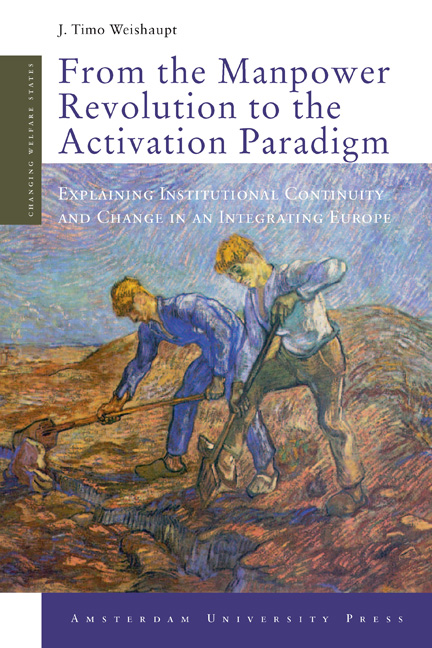 From the Manpower Revolution to the Activation Paradigm
From the Manpower Revolution to the Activation Paradigm Book contents
- Frontmatter
- Contents
- List of Boxes, Figures and Tables
- Abbreviations
- Acknowledgements
- I Introduction
- II Theoretical Approach
- Part I Origin and Crisis of European Labour Market Policy Regimes
- Part II The Emergence of the Activation Paradigm
- List of Interviews and Personal Conversations
- Notes
- Bibliography
- Index
- Changing Welfare States
VII - Explaining Transformative Change in Two Crucial Cases
Published online by Cambridge University Press: 20 January 2021
- Frontmatter
- Contents
- List of Boxes, Figures and Tables
- Abbreviations
- Acknowledgements
- I Introduction
- II Theoretical Approach
- Part I Origin and Crisis of European Labour Market Policy Regimes
- Part II The Emergence of the Activation Paradigm
- List of Interviews and Personal Conversations
- Notes
- Bibliography
- Index
- Changing Welfare States
Summary
While chapter VI has offered an empirical overview of the institutional changes that have taken place in Western Europe over roughly the past decade, this chapter will shed light on the political processes underlying these institutional changes. The analytical focus thus shifts from policy to politics and from institutions to actors. Since an in-depth analysis of six country cases goes beyond the scope of this book, I will focus on two of the six cases. Germany and Ireland have been selected as “crucial” cases, or cases “particularly informative for theory development” (George and Bennett 2005, 253). Germany is the archetypical Continental welfare state and co-ordinated market economy (CME), which makes it a “most likely” case for a path-dependent trajectory. Germany is also, however, one of the world's largest economies and the economic “engine” of the European Union. As such, pressures raised by proponents of the Globalisation Thesis should therefore be particularly prominent there. However, in chapter VI, we saw that Germany's institutional trajectory significantly deviates from the path-dependency hypothesis, and it also fails to clearly conform to a trajectory toward a US-style endpoint. As such, an actor-centred analysis becomes crucial to explain why and how Germany's transformative institutional changes occurred, leading to the hybridisation of its labour market policy regime.
Ireland represents an empirically interesting case because it has become a source of inspiration for many of the Central and Eastern European countries that recently acceded to the EU. This is to say, the “Irish example is important because it shows how an output boom, supported by sensible changes in labour market structures and policies, turned one of Europe's worst performing labour markets into one of the best in less than a decade” (Walsh 2004, 19, emphasis added). Analytically, Ireland is interesting because it has significantly diverged from its British counterpart in many (but not all) respects. While this trajectory has already been labelled as hybridisation by leading scholars in the field (e.g., Zeitlin 2003; NESC 2005a) – an assessment, that I corroborated in chapter VI – in this chapter, I seek to explain when, how, and why Irish policymakers have introduced these “sensible changes”. My goal is to shed light on the circumstances and motivations that have led Irish policymakers to “mix and match” policies and structures from various regime types, which, in turn, allows me to explain how this process of hybridisation has become possible politically.
- Type
- Chapter
- Information
- From the Manpower Revolution to the Activation ParadigmExplaining Institutional Continuity and Change in an Integrating Europe, pp. 253 - 294Publisher: Amsterdam University PressPrint publication year: 2012


